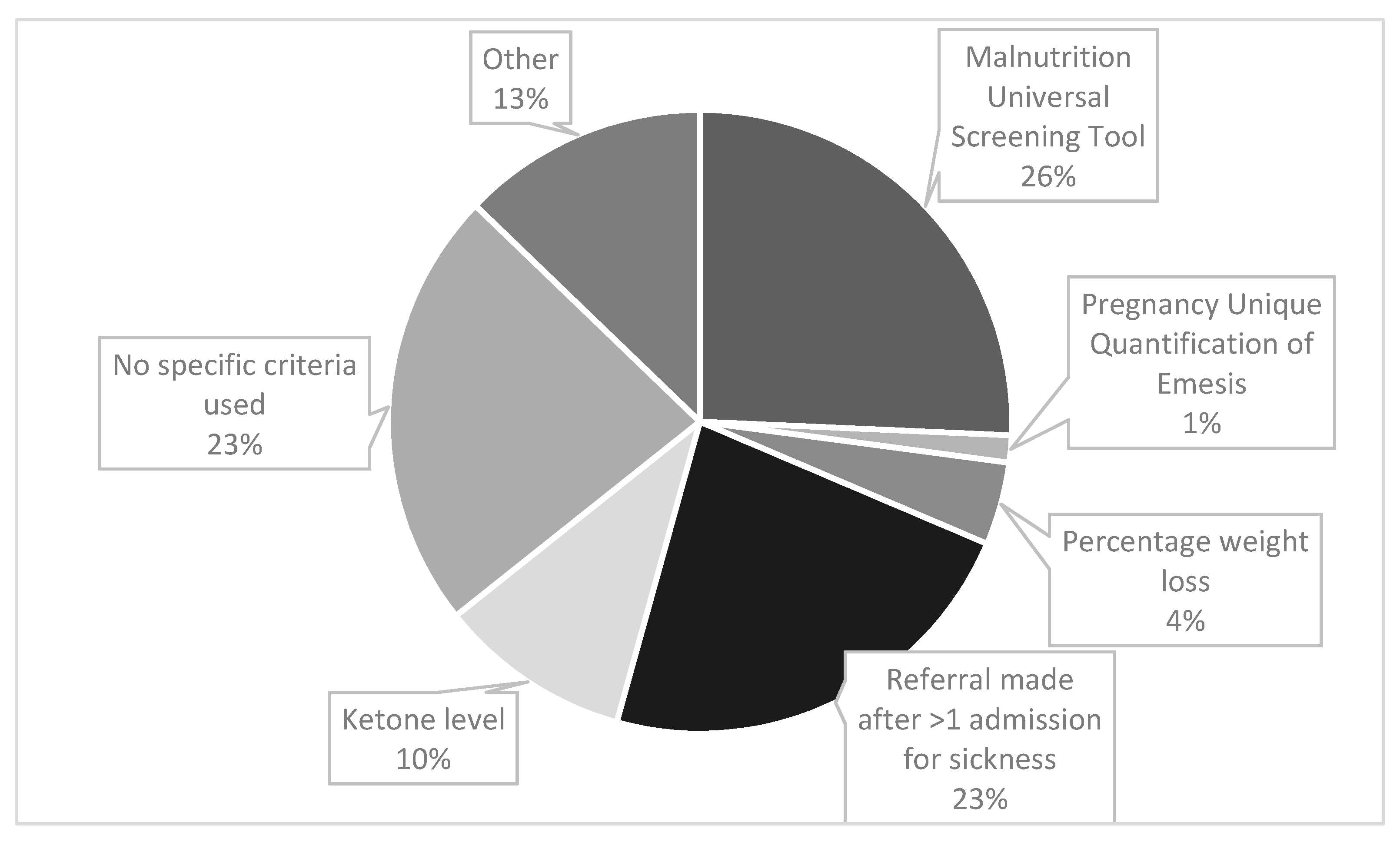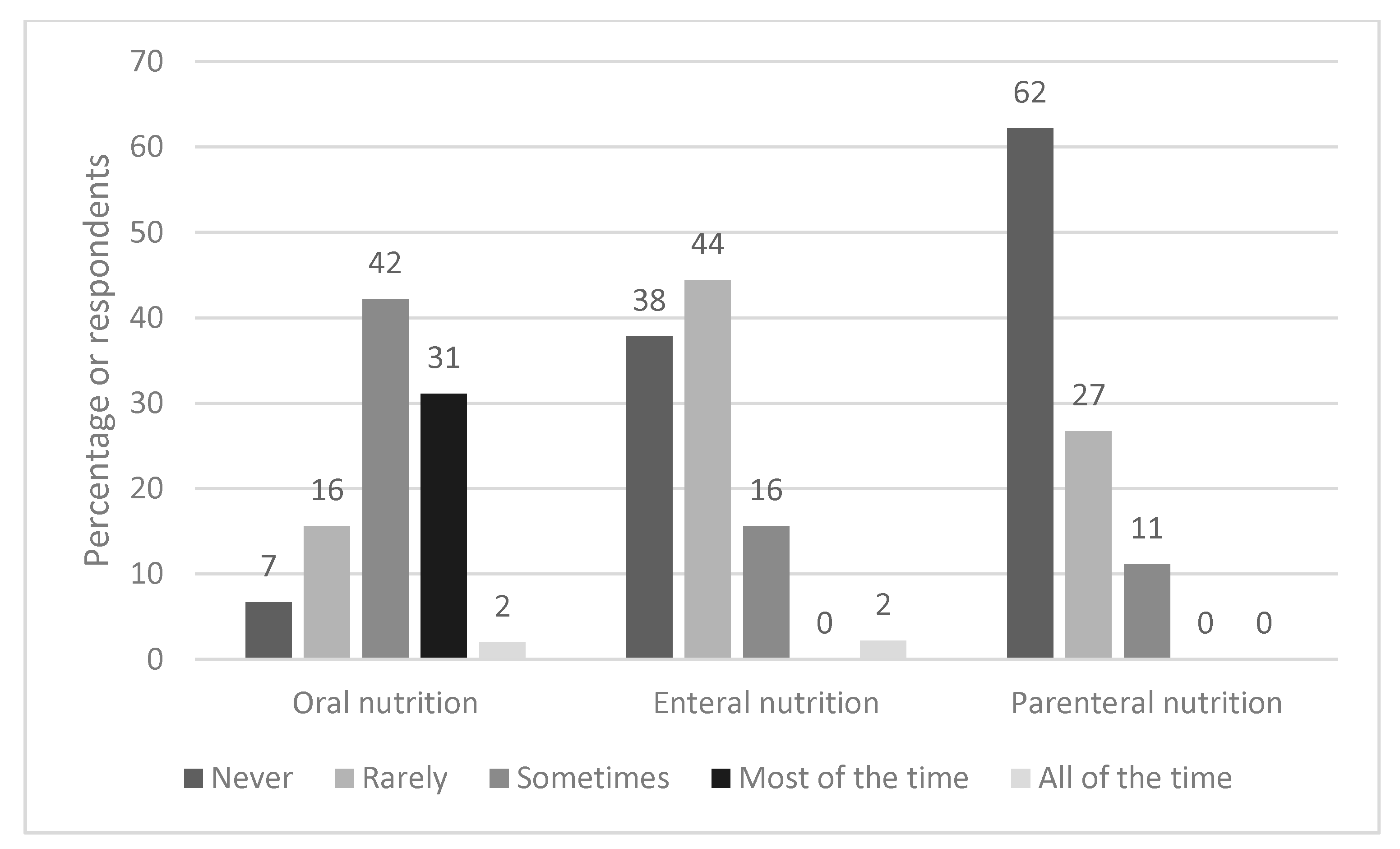The Contribution of Registered Dietitians in the Management of Hyperemesis Gravidarum in the United Kingdom
Abstract
1. Introduction
2. Materials and Methods
2.1. Participants and Recruitment
2.2. Survey Design and Piloting
2.3. Data Analysis and Storage
3. Results
3.1. Participant Characteristics, Clinical Setting and Role
3.2. Referral Pathway and Criteria
3.3. Clinical Management
3.4. Use of Oral Supplements, Enteral and Parenteral Nutrition Support
3.5. Improvement of Care
- A need to increase awareness and training for healthcare professionals;
- Improved guidance for dietetic referral and management of HG;
- Improved capacity/priority for dietitians to cope with the issue.
4. Discussion
5. Conclusions
Supplementary Materials
Author Contributions
Funding
Institutional Review Board Statement
Informed Consent Statement
Data Availability Statement
Acknowledgments
Conflicts of Interest
References
- Einarson, T.R.; Piwko, C.; Koren, G. Quantifying the global rates of nausea and vomiting of pregnancy: A meta analysis. J. Popul. Ther. Clin. Pharmacol. 2013, 20, e171–e183. [Google Scholar] [PubMed]
- Fiaschi, L.; Nelson-Piercy, C.; Tata, L.J. Hospital admission for hyperemesis gravidarum: A nationwide study of occurrence, reoccurrence and risk factors among 8.2 million pregnancies. Hum. Reprod. 2016, 31, 1675–1684. [Google Scholar] [CrossRef] [PubMed]
- Vikanes, A.; Grjibovski, A.M.; Vangen, S.; Magnus, P. Variations in prevalence of hyperemesis gravidarum by country of birth: A study of 900,074 pregnancies in Norway, 1967–2005. Scand. J. Public Health 2008, 36, 135–142. [Google Scholar] [CrossRef]
- Fiaschi, L.; Nelson-Piercy, C.; Deb, S.; King, R.; Tata, L.J. Clinical management of nausea and vomiting in pregnancy and hyperemesis gravidarum across primary and secondary care: A population-based study. Br. J. Obstet. Gynaecol. 2019, 126, 1201–1211. [Google Scholar] [CrossRef] [PubMed]
- Nurmi, M.; Rautava, P.; Gissler, M.; Vahlberg, T.; Polo-Kantola, P. Incidence and risk factors of hyperemesis gravidarum: A national register-based study in Finland, 2005–2017. Acta Obstet. Gynecol. Scand. 2020, 99, 1003–1013. [Google Scholar] [CrossRef] [PubMed]
- Einarson, T.R.; Piwko, C.; Koren, G. Prevalence of nausea and vomiting of pregnancy in the USA: A meta analysis. J. Popul. Ther. Clin. Pharmacol. 2013, 20, e163–e170. [Google Scholar] [PubMed]
- Royal College of Obstetricians and Gynaecologists. The Management of Nausea and Vomiting of Pregnancy and Hyperemesis Gravidarum; Green-top Guideline No. 69; RCOG: London, UK, June 2016. [Google Scholar]
- Fejzo, M.S.; Trovik, J.; Grooten, I.J.; Sridharan, K.; Roseboom, T.J.; Vikanes, Å.; Painter, R.C.; Mullin, P.M. Nausea and vomiting of pregnancy and hyperemesis gravidarum. Nat. Rev. Dis. Primers 2019, 5, 62. [Google Scholar] [CrossRef]
- Macgibbon, K.W. Hyperemesis Gravidarum: Strategies to Improve Outcomes. J. Infus. Nurs. 2020, 43, 78–96. [Google Scholar] [CrossRef]
- Mullin, P.M.; Ching, C.; Schoenberg, F.; MacGibbon, K.; Romero, R.; Goodwin, T.M.; Fejzo, M.S. Risk factors, treatments, and outcomes associated with prolonged hyperemesis gravidarum. J. Matern. Fetal Neonatal Med. 2012, 25, 632–636. [Google Scholar] [CrossRef]
- Fejzo, M.S.; Poursharif, B.; Korst, L.M.; Munch, S.; MacGibbon, K.W.; Romero, R.; Goodwin, T.M. Symptoms and pregnancy outcomes associated with extreme weight loss among women with hyperemesis gravidarum. J. Women’s Health 2009, 18, 1981–1987. [Google Scholar] [CrossRef]
- Ayyavoo, A.; Derraik, J.G.; Hofman, P.L.; Biggs, J.; Bloomfield, F.H.; Cormack, B.E.; Stone, P.; Cutfield, W.S. Severe hyperemesis gravidarum is associated with reduced insulin sensitivity in the offspring in childhood. J. Clin. Endocrinol. Metab. 2013, 98, 3263–3268. [Google Scholar] [CrossRef] [PubMed][Green Version]
- Getahun, D.; Fassett, M.J.; Jacobsen, S.J.; Xiang, A.H.; Takhar, H.S.; Wing, D.A.; Peltier, M.R. Autism Spectrum Disorders in Children Exposed in Utero to Hyperemesis Gravidarum. Am. J. Perinatol. 2019. [Google Scholar] [CrossRef]
- Fejzo, M.; MacGibbon, K.; Mullin, P.M. Why are Women Still Dying from Nausea and Vomiting of Pregnancy? Gynecol. Obstet. Case Rep. 2016, 2, 1–4. [Google Scholar] [CrossRef]
- Fejzo, M.S.; Sazonova, O.V.; Sathirapongsasuti, J.F.; Hallgrimsdottir, I.B.; Vacic, V.; MacGibbon, K.W.; Schoenberg, F.P.; Mancuso, N.; Slamon, D.J.; Mullin, P.M. Placenta and appetite genes GDF15 and IGFBP7 are associated with hyperemesis gravidarum. Nat. Commun. 2018, 9, 1178. [Google Scholar] [CrossRef] [PubMed]
- O’Donnell, A.; McParlin, C.; Robson, S.C.; Beyer, F.; Moloney, E.; Bryant, A.; Bradley, J.; Muirhead, C.; Nelson-Piercy, C.; Newbury-Birch, D.; et al. Treatments for hyperemesis gravidarum and nausea and vomiting in pregnancy: A systematic review and economic assessment. Health Technol. Assess 2016, 20, 1–268. [Google Scholar] [CrossRef]
- Maslin, K.; Shaw, V.; Dean, C.; Brown, A.; Shawe, J. What is known about the nutritional intake of women with Hyperemesis Gravidarum? A scoping review. Eur. J. Obstet. Reprod. Biol. 2020, 257, 76–83. [Google Scholar] [CrossRef]
- Grooten, I.J.; Mol, B.W.; van der Post, J.A.M.; Ris-Stalpers, C.; Kok, M.; Bais, J.M.J.; Bax, C.J.; Duvekot, J.J.; Bremer, H.A.; Porath, M.M.; et al. Early nasogastric tube feeding in optimising treatment for hyperemesis gravidarum: The MOTHER randomised controlled trial (Maternal and Offspring outcomes after Treatment of HyperEmesis by Refeeding). BMC Pregnancy Childbirth 2016, 16, 1–6. [Google Scholar] [CrossRef]
- Boelig, R.C.; Barton, S.J.; Saccone, G.; Kelly, A.J.; Edwards, S.J.; Berghella, V. Interventions for treating hyperemesis gravidarum. Cochrane Database Syst. Rev. 2016, CD010607. [Google Scholar] [CrossRef]
- Dean, C.R.; Bierma, H.; Clarke, R.; Cleary, B.; Ellis, P.; Gadsby, R.; Gauw, N.; Lodge, K.; MacGibbon, K.; McBride, M.; et al. A patient-clinician James Lind Alliance partnership to identify research priorities for hyperemesis gravidarum. BMJ Open 2021, 11, e041254. [Google Scholar] [CrossRef]
- Stokke, G.; Gjelsvik, B.L.; Flaatten, K.T.; Birkeland, E.; Flaatten, H.; Trovik, J. Hyperemesis gravidarum, nutritional treatment by nasogastric tube feeding: A 10-year retrospective cohort study. Acta Obstet. Gynecol. Scand. 2015, 94, 359–367. [Google Scholar] [CrossRef]
- IBM. IBM SPSS Statistics for Windows, Version 24.0; IBM Corp: Armonk, NY, USA, 2016. [Google Scholar]
- Braun, V.; Clarke, V. Using thematic analysis in psychology. Qual. Res. Psychol. 2006, 3, 77–101. [Google Scholar] [CrossRef]
- Elia, M. The ‘MUST’ Report. Nutritional Screening of Adults: A Multidisciplinary Responsibility. Development and Use of the ‘Malnutrition Universal Screening Tool’ (‘MUST’) for Adults, Malnutrition Advisory Group (MAG), Standing Committee of BAPEN., Redditch, Worcs. 2003. Available online: https://www.bapen.org.uk/pdfs/must/must-report.pdf (accessed on 15 March 2021).
- Havnen, G.C.; Truong, M.B.; Do, M.H.; Heitmann, K.; Holst, L.; Nordeng, H. Women’s perspectives on the management and consequences of hyperemesis gravidarum—A descriptive interview study. Scand. J. Prim. Health Care 2019, 37, 30–40. [Google Scholar] [CrossRef] [PubMed]
- Cederholm, T.; Barazzoni, R.; Austin, P.; Ballmer, P.; Biolo, G.; Bischoff, S.C.; Compher, C.; Correia, I.; Higashiguchi, T.; Holst, M.; et al. ESPEN guidelines on definitions and terminology of clinical nutrition. Clin. Nutr. 2017, 36, 49–64. [Google Scholar] [CrossRef] [PubMed]
- National Institute for Health and Care Excellence. Nutrition Support for Adults: Oral Nutrition Support, Enteral Tube Feeding and Parenteral Nutrition; Clinical Guidelines [CG32]; National Institute for Health and Care Excellence: London, UK, 2006; Updated 2017. [Google Scholar]
- Academy of Nutrition and Dietetics Evidence Analysis Library. Malnutrition in Pregnancy Systematic Review. 2018. Available online: https://www.andeal.org/topic.cfm?menu=5529 (accessed on 15 March 2021).
- Ebrahimi, N.; Maltepe, C.; Einarson, A. Optimal management of nausea and vomiting of pregnancy. Int. J. Women’s Health 2010, 2, 241–248. [Google Scholar] [CrossRef]
- King, T.L.; Murphy, P.A. Evidence-based approaches to managing nausea and vomiting in early pregnancy. J. Midwifery Women’s Health 2009, 54, 430–444. [Google Scholar] [CrossRef]
- Chandra, K.; Magee, L.; Einarson, A.; Koren, G. Nausea and vomiting in pregnancy: Results of a survey that identified interventions used by women to alleviate their symptoms. J. Psychosom. Obstet. Gynaecol. 2003, 24, 71–75. [Google Scholar] [CrossRef]
- Goodwin, T.M.; Poursharif, B.; Korst, L.M.; MacGibbon, K.W.; Romero, R.; Fejzo, M.S. Secular trends in the treatment of hyperemesis gravidarum. Am. J. Perinatol. 2008, 25, 141–147. [Google Scholar] [CrossRef] [PubMed]
- McSherry, C.; Belton, E.A. A survey of the opinions, attitudes, and current involvement of UK dietitians in antenatal and maternity care services. J. Hum. Nutr. Diet. 2009, 22, 256–275. [Google Scholar] [CrossRef]


| Response Options | % (n) | |
|---|---|---|
| Clinical setting | Secondary care NHS hospital Tertiary care NHS hospital Specialist NHS maternity hospital Private hospital Other | 76 (34) 11 (5) 4 (2) 0 (0) 9 (4) |
| Country | England Scotland Wales Northern Ireland | 64 (29) 11 (5) 9 (4) 16 (7) |
| Work experience as a dietitian | <2 years 2–5 years 6–10 years >10 years | 16 (7) 24 (11) 9 (4) 51 (23) |
| Main role/specialism | General/newly qualified Gastroenterology Nutrition Support Team Maternal health dietitian Other 1 | 20 (9) 16 (7) 20 (9) 11 (5) 36 (16) |
| Service level agreement to provide dietetic cover to maternity/obstetrics patients | Yes No Don’t know | 40 (18) 42 (19) 18 (8) |
| Setting where HG patients usually seen | Inpatient Outpatient Day case setting Other | 78 (35) 40 (18) 13 (6) 4 (2) |
| Access to day unit rehydration service for HG patients in place of work | Yes No Not sure | 18 (8) 44 (20) 38 (17) |
| Theme | Sub-Theme | Example Quotes |
|---|---|---|
| 1. A need to increase awareness & training for HCPs | Need to increase awareness amongst HCPs |
|
| Improved training of HCPs |
| |
| 2. Improved guidance for dietetic referral and management of HG | Improved guidance for referral for dietetic input |
|
| Improved guidance for dietetic management |
| |
| 3. Improved capacity/priority for dietitians to cope with the issue |
|
Publisher’s Note: MDPI stays neutral with regard to jurisdictional claims in published maps and institutional affiliations. |
© 2021 by the authors. Licensee MDPI, Basel, Switzerland. This article is an open access article distributed under the terms and conditions of the Creative Commons Attribution (CC BY) license (https://creativecommons.org/licenses/by/4.0/).
Share and Cite
Maslin, K.; Billson, H.A.; Dean, C.R.; Abayomi, J. The Contribution of Registered Dietitians in the Management of Hyperemesis Gravidarum in the United Kingdom. Nutrients 2021, 13, 1964. https://doi.org/10.3390/nu13061964
Maslin K, Billson HA, Dean CR, Abayomi J. The Contribution of Registered Dietitians in the Management of Hyperemesis Gravidarum in the United Kingdom. Nutrients. 2021; 13(6):1964. https://doi.org/10.3390/nu13061964
Chicago/Turabian StyleMaslin, Kate, Hazel A. Billson, Caitlin R. Dean, and Julie Abayomi. 2021. "The Contribution of Registered Dietitians in the Management of Hyperemesis Gravidarum in the United Kingdom" Nutrients 13, no. 6: 1964. https://doi.org/10.3390/nu13061964
APA StyleMaslin, K., Billson, H. A., Dean, C. R., & Abayomi, J. (2021). The Contribution of Registered Dietitians in the Management of Hyperemesis Gravidarum in the United Kingdom. Nutrients, 13(6), 1964. https://doi.org/10.3390/nu13061964







